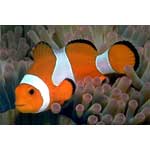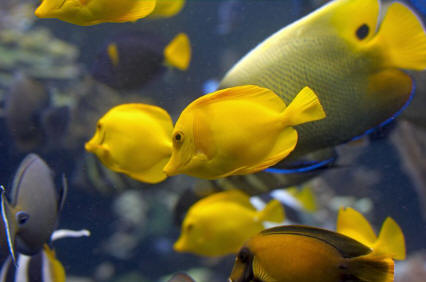Common Clown

|
Scientific Name: Amphiprion ocellaris Price: Upon Request Origin: South East Asia Family: Pomacentridae NOT AVAILABLE NOW |
|
Other Names: Nemo Clown Fish |
|
Technical Info
Temperature: 22 - 25 ℃
pH: 8.1 - 8.4
GH: 8 - 12
SG: 1.020 - 1.025
Max size: 8 cm
Min Tank size: 70 Ltr
Position in Aqua: No special swimming level
Description
The Ocellaris Clownfish may be one of the aquarium industry's most popular marine fish. Its beautiful orange body dressed with white bands outlined in black instantly distinguishes the Ocellaris Clownfish. This member of the Pomacentridae family is an excellent addition to almost any saltwater aquarium system. What makes this specific variety even more appealing to aquarists is the fact that each Ocellaris Clownfish is tank-bred to help protect the fragile reef environments of the world.
Food
Clownfish in captivity are the easiest fishes to feed because they will eat just about anything offered. They are omnivores that will eat algae based foods as well as meaty foods. They should be offered a variety of foods. First, get them on a good dry food. Mix their diet of pellets with some frozen foods.
Breeding
The Ocellaris Clownfish is also easy to breed in the home aquarium. The females will be the largest of the pair and the two fish will usually stay close to each other in the aquarium. The Tank-Bred Ocellaris Clownfish is an egg layer and will deposit the eggs on a flat surface and defend the eggs from other tankmates. The eggs will normally hatch in 6-11 days depending on the water temperature. The fry must be reared in a separate aquarium on a diet of rotifers followed by baby brine shrimp.
Compatible with
The ocellaris clownfish is a peaceful fish that gets along well with others, big or small. They do not however, get along with other clownfish. Putting two large ocellaris (possibly females) together in a small tank will see them fighting round the clock.
Note
All clownfish are born sexless, develop into males and have the potential to become a female. I say potential because only the strongest, most dominant clownfish in the group will turn in to a female. Should she perish, the next strongest male will begin changing into a female to take her place. In a group, the female will be the largest clownfish present.

